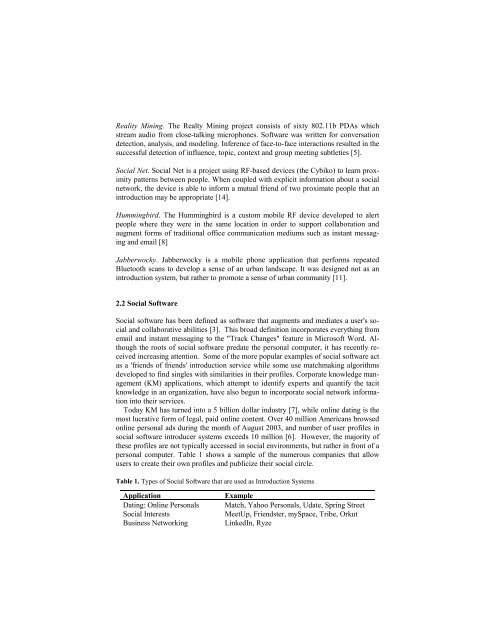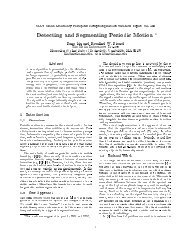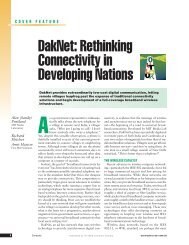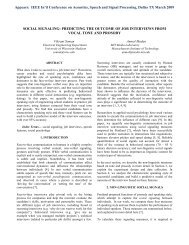Social Serendipity: Proximity Sensing and Cueing - Human ...
Social Serendipity: Proximity Sensing and Cueing - Human ...
Social Serendipity: Proximity Sensing and Cueing - Human ...
Create successful ePaper yourself
Turn your PDF publications into a flip-book with our unique Google optimized e-Paper software.
Reality Mining. The Realty Mining project consists of sixty 802.11b PDAs which<br />
stream audio from close-talking microphones. Software was written for conversation<br />
detection, analysis, <strong>and</strong> modeling. Inference of face-to-face interactions resulted in the<br />
successful detection of influence, topic, context <strong>and</strong> group meeting subtleties [5].<br />
<strong>Social</strong> Net. <strong>Social</strong> Net is a project using RF-based devices (the Cybiko) to learn proximity<br />
patterns between people. When coupled with explicit information about a social<br />
network, the device is able to inform a mutual friend of two proximate people that an<br />
introduction may be appropriate [14].<br />
Hummingbird. The Hummingbird is a custom mobile RF device developed to alert<br />
people where they were in the same location in order to support collaboration <strong>and</strong><br />
augment forms of traditional office communication mediums such as instant messaging<br />
<strong>and</strong> email [8]<br />
Jabberwocky. Jabberwocky is a mobile phone application that performs repeated<br />
Bluetooth scans to develop a sense of an urban l<strong>and</strong>scape. It was designed not as an<br />
introduction system, but rather to promote a sense of urban community [11].<br />
2.2 <strong>Social</strong> Software<br />
<strong>Social</strong> software has been defined as software that augments <strong>and</strong> mediates a user's social<br />
<strong>and</strong> collaborative abilities [3]. This broad definition incorporates everything from<br />
email <strong>and</strong> instant messaging to the "Track Changes" feature in Microsoft Word. Although<br />
the roots of social software predate the personal computer, it has recently received<br />
increasing attention. Some of the more popular examples of social software act<br />
as a 'friends of friends' introduction service while some use matchmaking algorithms<br />
developed to find singles with similarities in their profiles. Corporate knowledge management<br />
(KM) applications, which attempt to identify experts <strong>and</strong> quantify the tacit<br />
knowledge in an organization, have also begun to incorporate social network information<br />
into their services.<br />
Today KM has turned into a 5 billion dollar industry [7], while online dating is the<br />
most lucrative form of legal, paid online content. Over 40 million Americans browsed<br />
online personal ads during the month of August 2003, <strong>and</strong> number of user profiles in<br />
social software introducer systems exceeds 10 million [6]. However, the majority of<br />
these profiles are not typically accessed in social environments, but rather in front of a<br />
personal computer. Table 1 shows a sample of the numerous companies that allow<br />
users to create their own profiles <strong>and</strong> publicize their social circle.<br />
Table 1. Types of <strong>Social</strong> Software that are used as Introduction Systems<br />
Application<br />
Dating: Online Personals<br />
<strong>Social</strong> Interests<br />
Business Networking<br />
Example<br />
Match, Yahoo Personals, Udate, Spring Street<br />
MeetUp, Friendster, mySpace, Tribe, Orkut<br />
LinkedIn, Ryze






